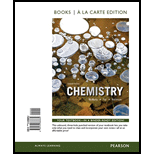
APPLY 14.4 Lactic acid, which builds up in muscle tissue upon strenuous exercise, is partially dissociated in aqueous solution:

The following equilibrium concentrations were measured at 25°C:
Lactic acid
Lactate ion [C3H5O3-] = 3.65 × 10-3 M.
(a) Calculate the value of the equilibrium constant.
(b) What is the concentration of lactic acid (C3H6O3) if at equilibrium
Want to see the full answer?
Check out a sample textbook solution
Chapter 14 Solutions
Chemistry, Books a la Carte Plus Mastering Chemistry with eText -- Access Card Package (7th Edition)
- Write an equation for an equilibrium system that would lead to the following expressions (ac) for K. (a) K=(Pco)2 (PH2)5(PC2H6)(PH2O)2 (b) K=(PNH3)4 (PO2)5(PNO)4 (PH2O)6 (c) K=[ ClO3 ]2 [ Mn2+ ]2(Pcl2)[ MNO4 ]2 [ H+ ]4 ; liquid water is a productarrow_forwardFor the following reactions, predict whether the pressure of the reactants or products increases or remains the same when the volume of the reaction vessel is increased. (a) H2O(l)H2O(g) (b) N2(g)+3H2(g)2NH3(g) (c) C2H4(g)+H2O(g)C2H5OH(g)arrow_forwardConsider the system 4NH3(g)+3O2(g)2N2(g)+6H2O(l)H=1530.4kJ (a) How will the concentration of ammonia at equilibrium be affected by (1) removing O2(g)? (2) adding N2(g)? (3) adding water? (4) expanding the container? (5) increasing the temperature? (b) Which of the above factors will increase the value of K? Which will decrease it?arrow_forward
- Show that the complete chemical equation, the total ionic equation, and the net ionic equation for the reaction represented by the equation KI(aq)+I2(aq)KI3(aq) give the same expression for the reaction quotient. KI3 is composed of the ions K+ and I3-.arrow_forwardAt a temperature of 60 C, the vapor pressure of water is 0.196 atm. What is the value of the equilibrium constant KP for the transformation at 60 C? H2O(l)H2O(g)arrow_forwardHow is the strength of an acid related to the position of its ionization equilibrium? Write the equations for the dissociation (ionization) of HCI, HNO3, and HClO4in water. Since all these acids are strong acids, what does this indicate about the basicity of the Cl-, NO3, and ClO4ions? Are aqueous solutions of NaCl, NaNO3, or NaClO4basic?arrow_forward
- 7-40 Is there any change in conditions that change the equilibrium constant, K, of a given reaction?arrow_forwardFor the system SO3(g)SO2(g)+12 O2(g)at 1000 K, K=0.45. Sulfur trioxide, originally at 1.00 atm pressure, partially dissociates to SO2 and O2 at 1000 K. What is its partial pressure at equilibrium?arrow_forwardA small quantity of a soluble salt is placed in water. Equilibrium between dissolved and undissolved salt may or may not be attained. Explain.arrow_forward
- Iodine chloride decomposes at high temperatures to iodine and chlorine gases. 2ICl(g)I2(g)+Cl2(g)Equilibrium is established at a certain temperature when the partial pressures of ICl, I2, and Cl2 are (in atm) 0.43, 0.16, and 0.27, respectively. (a) Calculate K. (b) If enough iodine condenses to decrease its partial pressure to 0.10 atm, in which direction will the reaction proceed? What is the partial pressure of iodine when equilibrium is reestablished?arrow_forwardHydrogen iodide gas decomposes to hydrogen gas and iodine gas: 2HI(g)H2(g)+I2(g)To determine the equilibrium constant of the system, identical one-liter glass bulbs are filled with 3.20 g of HI and maintained at a certain temperature. Each bulb is periodically opened and analyzed for iodine formation by titration with sodium thiosulfate, Na2S2O3. I2(aq)+2S2O32(aq)S4O62(aq)+2 I(aq)It is determined that when equilibrium is reached, 37.0 mL of 0.200 M Na2S2O3 is required to titrate the iodine. What is K at the temperature of the experiment?arrow_forwardSuppose a reaction has the equilibrium constant K = 1.3 108. What does the magnitude of this constant tell you about the relative concentrations of products and reactants that will be present once equilibrium is reached? Is this reaction likely to be a good source of the products?arrow_forward
 Introduction to General, Organic and BiochemistryChemistryISBN:9781285869759Author:Frederick A. Bettelheim, William H. Brown, Mary K. Campbell, Shawn O. Farrell, Omar TorresPublisher:Cengage Learning
Introduction to General, Organic and BiochemistryChemistryISBN:9781285869759Author:Frederick A. Bettelheim, William H. Brown, Mary K. Campbell, Shawn O. Farrell, Omar TorresPublisher:Cengage Learning Chemistry for Engineering StudentsChemistryISBN:9781337398909Author:Lawrence S. Brown, Tom HolmePublisher:Cengage Learning
Chemistry for Engineering StudentsChemistryISBN:9781337398909Author:Lawrence S. Brown, Tom HolmePublisher:Cengage Learning ChemistryChemistryISBN:9781305957404Author:Steven S. Zumdahl, Susan A. Zumdahl, Donald J. DeCostePublisher:Cengage Learning
ChemistryChemistryISBN:9781305957404Author:Steven S. Zumdahl, Susan A. Zumdahl, Donald J. DeCostePublisher:Cengage Learning Chemistry: An Atoms First ApproachChemistryISBN:9781305079243Author:Steven S. Zumdahl, Susan A. ZumdahlPublisher:Cengage Learning
Chemistry: An Atoms First ApproachChemistryISBN:9781305079243Author:Steven S. Zumdahl, Susan A. ZumdahlPublisher:Cengage Learning
 World of Chemistry, 3rd editionChemistryISBN:9781133109655Author:Steven S. Zumdahl, Susan L. Zumdahl, Donald J. DeCostePublisher:Brooks / Cole / Cengage Learning
World of Chemistry, 3rd editionChemistryISBN:9781133109655Author:Steven S. Zumdahl, Susan L. Zumdahl, Donald J. DeCostePublisher:Brooks / Cole / Cengage Learning





